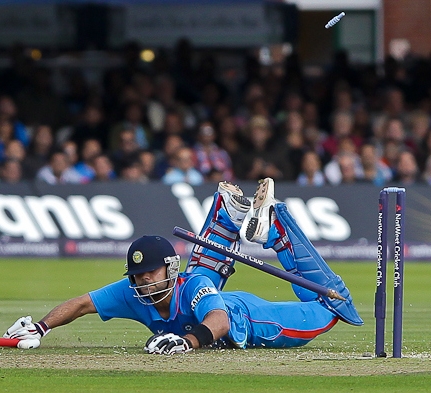Cut down Old Cricket Bats to Gain Match Day Precision

I spent the weekend heading up the Cricket Zone at SportFest15 in the grounds of the glorious Wormsley Estate. 1000's of children were coached by Sporting legends over the two day festival.
The Cricket zone had 6 areas including the PitchVision net manned by Andrew Strauss and Simon Jones.
Another section is called "bowl at Hoggy's Stump". In 2014, England legend, Matthew Hoggard batted for 2 days in a net armed only with a stump. The children loved it, so did Hoggy!
This year we upgraded the stump to a middling bat.
Drills to Improve Playing Fast Bowling

England's disarray against fast bowling at Lord's was not a surprise to those who have watched them closely over the years.
Despite Lords being a very good batting track, England seemed clueless against the fast bowling onslaught in the 4th innings.
Australia shifted their length of attack to push the batters back and then pitched the ball fuller to bring the stumps in or get the edge. The classic combination of short, short, full. The same combination that undid them in Australia 18 months ago.
So what can be done in this situation?
Here are some drills.
Cricket Fielding Drill: Round the Ring
This drill is part of the PitchVision Academy fielding drills series, for more in this series click here.
Purpose: To practice realistic ring ground fielding, run outs and backing up.
Description: Set up with fielders at point, extra cover, midwicket and square leg. One extra fielder waits behind point. The coach is fed an underarm feed and hit the ball to point (position 1). The fielder pick up and throws down the non-striker stumps. She then moves across to extra cover.
Cricket Fielding Drill: Keep on Moving
This drill is part of the PitchVision Academy fielding drills series, for more in this series click here.
How to Prepare for Bowling into the Rough

One of the features of this Ashes series will be the battle between spinner and batters as the rough patches develop rapidly through each Test match. The weather in the UK has been (relatively) dry for months. The pitches are drier than usual for this time of year.
The Australian left arm seamers will help the rough patches to degrade at an accelerated rate outside the right handed batters off stump. This shall bring Moeen Ali and Nathan Lyon into the game earlier as attacking forces. It is likely that the Stokes, Anderson, Broad and Wood will bowl some overs around the wicket at David Warner, if he stays in long enough. This will also add wear and tear to that rough area.
The developing rough isn't just a problem for the batter. It also creates challenges for the keeper and the bowler as well. I know what you're saying; "Test match spinners shouldn't be challenged by the rough? It should be all their dreams come true!"
For bowlers such as Murali or Warne the rough represented opportunity. For most spinners, the developing footholds can represent a threat.
This threat is the pressure of expectation.
Get More Run Outs by Slowing Down
 "Run him out!"
"Run him out!"
The batsman had dropped the ball into the off side and called a quick single. His partner was slow off the mark.
The point fielder saw the chance early. He got low, moving swiftly to sweep up the ball. He had done it ten thousand times in practice and was drilled to aim at the base of the stump. The partnership was as broken as the wicket was about to be.
As he reached for the ball he was already imagining it flying to the stumps. Which is why he didn't grab it cleanly, overshot the trickling ball and raised his eyes to the sky in disgust while the batsmen scampered through without risk.
How many times a season do you see this in your team? How often have you done it yourself?
How to Improve Cricket Hand-Eye Coordination
 How many times have you thought "just watch the ball"?
How many times have you thought "just watch the ball"?
While it's a useful shorthand for having good eye to hand coordination, the truth is a lot more complex than simply keeping your eye on the ball. Of course, it's not an error to try and watch the ball. It's just that there is also a lot more you can do to get better at hitting, catching and stopping the ball too.
We can make this easy by breaking it down into direct and indirect ways.
How to Spice Up Cricket Warm Ups
Chris Watling has some advice for keeping the pre-game warm ups fun and functional.
How many times have you turned up to play, found your position in the changing room, and then dreaded the thought of another dull warm up?
Perhaps you are not like that, but you can be sure someone in your team is thinking along those lines. And they might well have a point. It is important to keep practice and warm ups varied. Variety is the spice of life. Varied warm ups add spice to your weekend cricket!
Here are some of my thoughts.
Slide, Dive, Collide: How to Avoid Boundary Catastrophe

Fielding in pairs.
Boundary riding.
Assisted catches.
These are common terms in the modern game. The best players playing with the best players in the IPL and the BBL have bought this to the forefront and we see some incredible fielding feats on club and school cricket grounds all across the world.
However, in the Regional T20 Semi Final of the National T20 Tournament the other day, I saw 2 separate collisions as two fielders both hurtled towards the ball with the same intention. To dive and stop the ball!
The commitment was huge and cannot be faulted. Yet, on another day we could have had a much worse outcome. One of the players cracked rib could have been a lot worse and the head injury could have been hideous.
So how can we help boundary riders to perform their skills and stay safe?
Turn Chaotic Nets into Performance Sessions with Just One Coach
How can one man coach a whole club?
This question is one that many a coach has been confronted with over the years. You've just been offered a senior coaching role at a new club. With visions of one-to-one discussions with batters, technical drills for bowlers, ongoing assessments and fitness development programs, your creative brain is firing.
Soon after, reality hits.
You’re coaching all four teams. They all train during the same two hour session once a week. Many will come and go at different times, and of course they all have a world of different issues they want to work on.
Oh, and you're on your own.
No assistant, no helpers, and no parents who you used to call upon when you were working with the juniors.
Don’t despair, there are still a few ways for you to make your sessions productive as long as you and your players can work to some simple guidelines.

